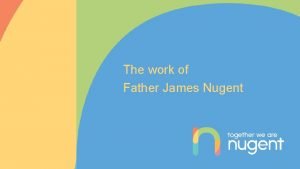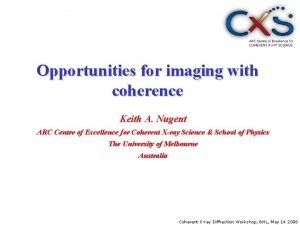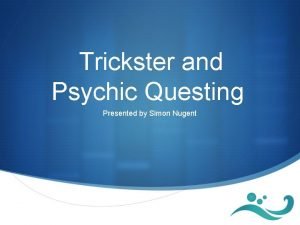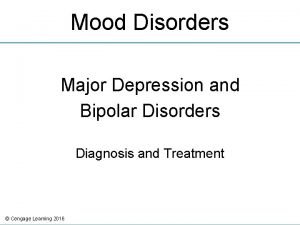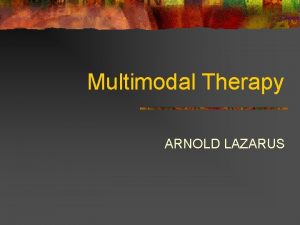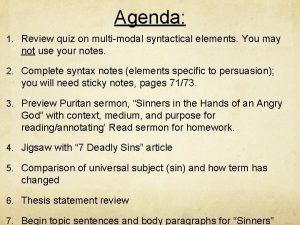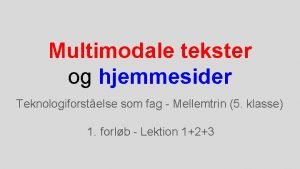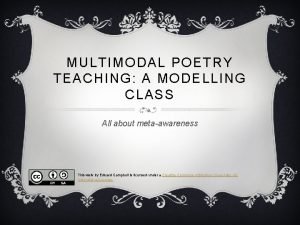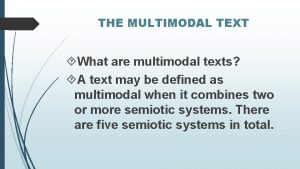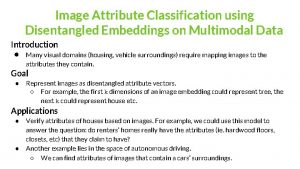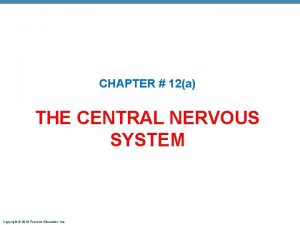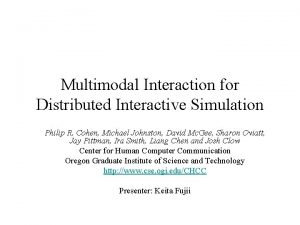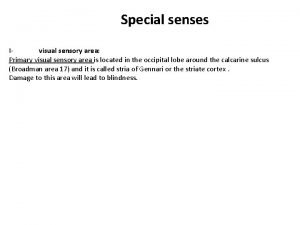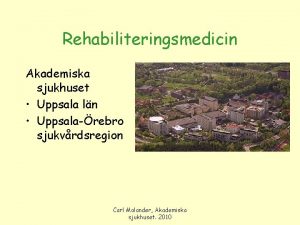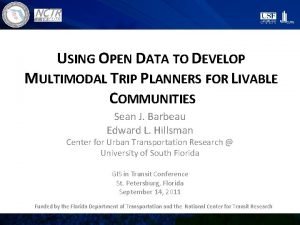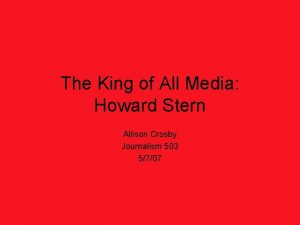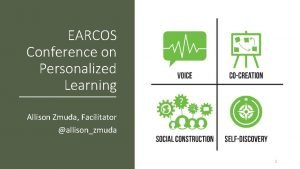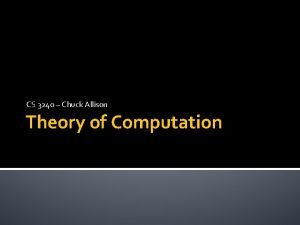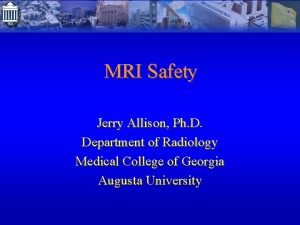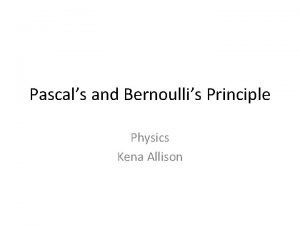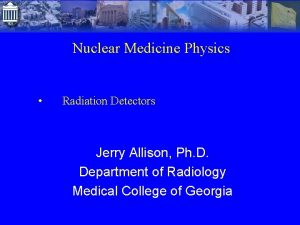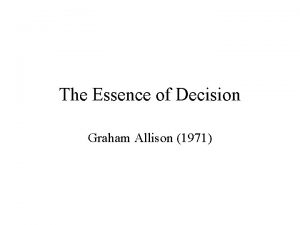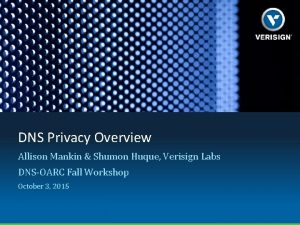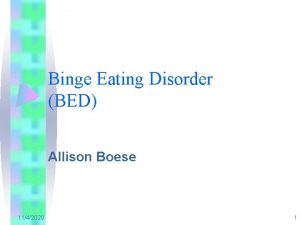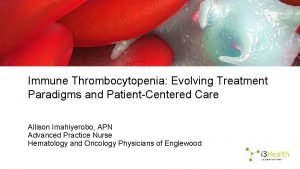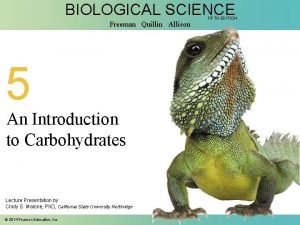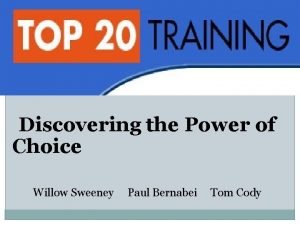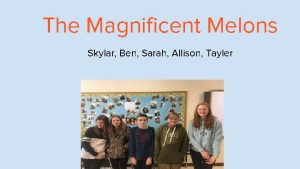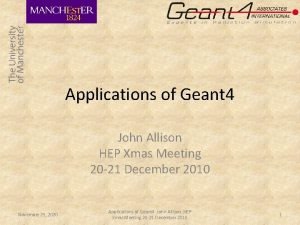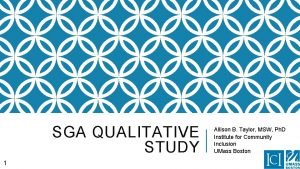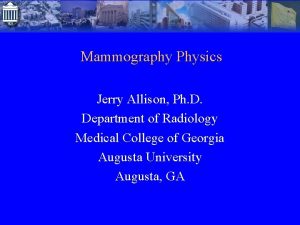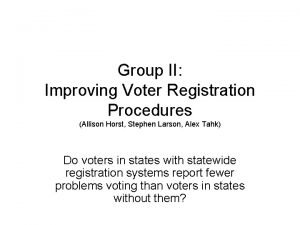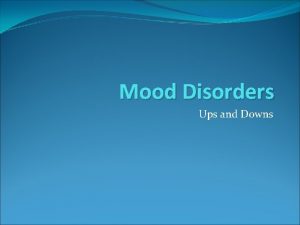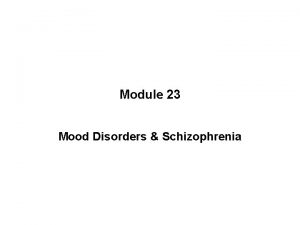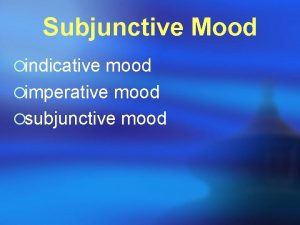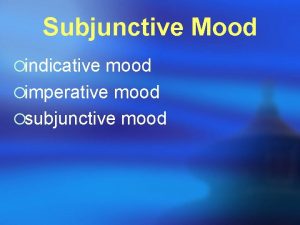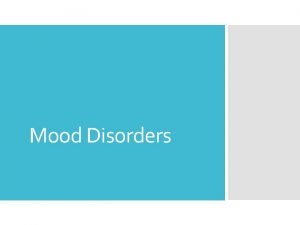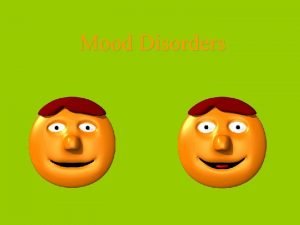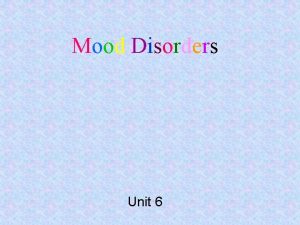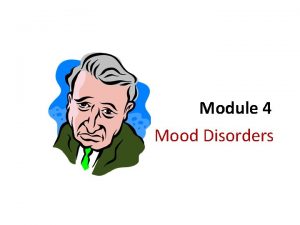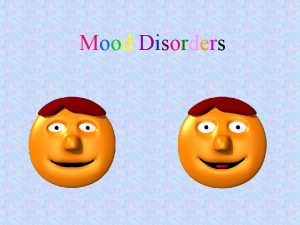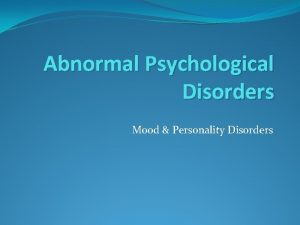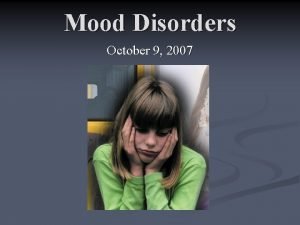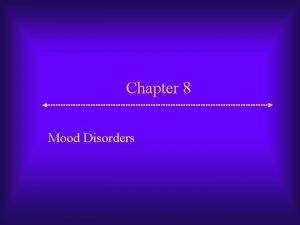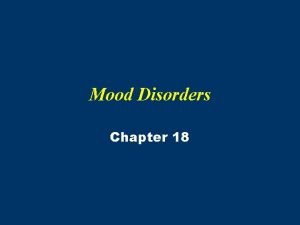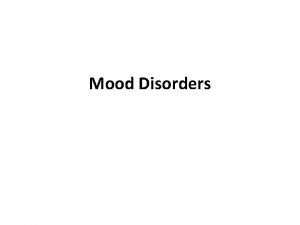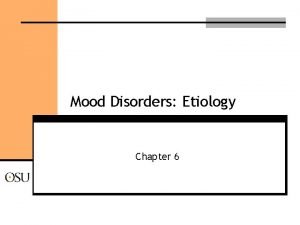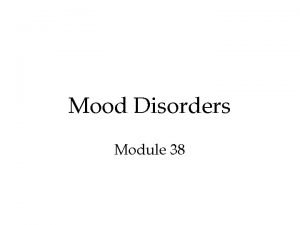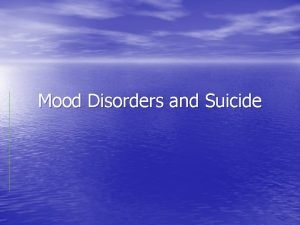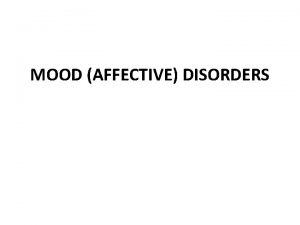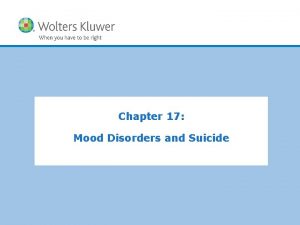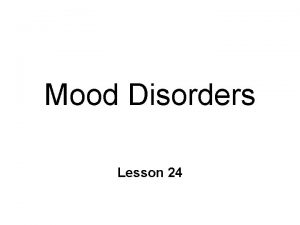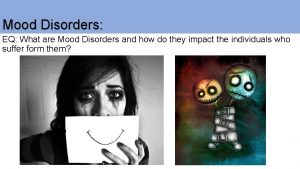Multimodal Imaging in Mood Disorders Allison C Nugent
































































- Slides: 64

Multimodal Imaging in Mood Disorders Allison C Nugent, Ph. D August 14, 2017

Outline • What are Mood Disorders? • The Neurobiology of Depression and Treatment • What can imaging teach us about Depression and its treatment? 2

Outline • What are Mood Disorders? • The Neurobiology of Depression and Treatment • What can imaging teach us about Depression and its treatment? 3

Mood Disorders • Depressive Disorders ■ Major Depressive Disorder ■ Post-partum Depression and Premenstrual Dysphoric Disorder ■ Seasonal Affective Disorder ■ Etc. • Bipolar Disorders 4 ■ Bipolar Disorder Types I and II ■ Cyclothymia

Mood Disorders • Major Depressive Disorder ■ Either depressed mood or anhedonia ■ Changes in sleep, weight, activity; feelings of guilt or worthlessness; problems with concentration; suicidality ■ Treatment is empirical; many drugs, none are terribly effective ■ STAR*D study: 2 trials or 6 months for 50% remission

Outline • What are Mood Disorders? • The Neurobiology of Depression and Treatment • What can imaging teach us about Depression and its treatment? 6

Neurobiology of Depression: Core Brain Regions • Subgenual cingulate cortex, BA 25 • Amygdala sg. ACC Amyg

Neurobiology of Depression: Less Simple

The Triple Network Model Menon V, Brain Mapping: An Encyclopedic Reference, (2015), vol. 2, pp. 597 -611

MDD: Pathogenesis and Treatment • Original Hypothesis : monoamine dysfunction ■ Norepinephrine ■ Serotonin ■ Dopamine • All currently approved drugs target the monoaminergic system 16 14 12 # of Mechanistically Distinct Drugs 10 Depression Schizophrenia Heart Disease 8 6 4 2 0 1950 s Present

Ketamine • FDA approved anesthetic and Schedule III controlled substance Hamilton Depression Rating Scale (HAMD) • NMDA receptor antagonist • Potent psychotomimetic effects 30 MDD 25 20 * 15 10 5 ** ** Placebo 0 -60 40 *** *** 80 110 230 1 Minutes 2 3 Days Drug Placebo Ketamine: Investigative Tool to study Rapid Antidepressant Effects 7

Rapid acting antidepressants: A common pathway of synaptogenesis? Ketamine Spine Synapse Number & Function Inhibitory Interneuron Musc. R NMDA GABA Glutamate AMPA NMDA GSK 3 PP 1 Adapted from Duman, 2014 Glutamate Burst BDNF AMPA GSK 3 Ca+ Trk. B ERK Akt m. TOR Akt

Ketamine: Active Metabolite • Alternative NMDA antagonist MK-801 does not elicit an antidepressant response • Metabolite (2 R, 6 R)-HNK does elicit an antidepressant response, but is not an NMDA antagonist • Both ketamine and (2 R, 6 R)-HNK enhance AMPA throughput. Zanos, et al. , Nature, 2016

Ketamine MOA study 14 days follow-up 14 days Medication Taper MDD (7 -14 Days) Placebo Ketamine (0. 5 mg/kg) Placebo Drug –free period MDD 14 days -MEG -PSG -PET -f. MRI -BDNF, VEGF -metabolomics, proteomic -Metabolites BASELINE MEG 3 T Multimodal MRI 7 T MRI Polysomnography ACUTE INTERIM MEG 3 T MRI 7 T MRI PSG

Ketamine MOA Study: Clinical Findings 15

Outline • What are Mood Disorders? • The Neurobiology of Depression and Treatment • What can imaging teach us about Depression and its treatment? 16

How can we use imaging? • Find brain “biomarkers” that can subdivide patients into distinct phenotypes • Find brain “biomarkers” that can reliably predict who will respond to a given intervention • Markers may change in response to treatment, and display a dose-response relationship

Potential Markers • Structure • Cognitive Function and Functional Imaging • Intrinsic Connectivity • Neurophysiology

Potential Markers • Structure • Cognitive Function and Functional Imaging • Intrinsic Connectivity • Neurophysiology

MDD and Brain Structure Koolschijn, et al. Human Brain Mapping (2009)

MDD and Brain Structure • High resolution hippocampal mapping at 7 T • Assessing curvature, surface area, and shape 3 T Thomas, Goodwin et al. 7 T

MDD and Brain Structure Significant negative association between length of current episode and reduced volume in the subicular subfield of the hippocampus. Thomas, Goodwin, et al.

MDD and Brain Structure – Amygdala?

Mood Disorders and Brain Structure: Cortex ENIGMA MDD Workgroup N=2148 MDD, N=7957 HC ENIGMA BD Workgroup N=2447 BD, N=4056 HC Schmaal, et al. , 2016 Hibar, et al. , 2017

MDD and Brain Structure: DTI • Meta-analysis • 3 TBSS studies, and 8 VBA studies • Reduced FA in CC, longitudinal fasciculus, fronto-occipital fasciculus, and thalamic radiation Liao, et al. (2013)

MDD and Brain Structure: DTI • Choi, et al. Neuropsychopharmacology (2014) 39(6): 1332 -1339. • MDD (N=134) and HC (N=54) • 98 treatment naïve MDD • All medication free • No differences found

MDD: Focused Analysis • Concentration on sg. ACC and Amygdala tracts, with additional hippocampus and thalamus regions of interest • Baseline imaging in 31 MDD and 26 HC subjects before ketamine treatment 27 Nugent, et al. , in preparation

Fractional Anisotropy DTI: MDD vs. HC, and response to ketamine Correlation: FA to MADRS Response to Ketamine 0, 45 0, 4 0, 35 0, 3 0, 25 0, 2 -100 -50 0 50 MADRS percent change at Day 1 R=0. 569, p=0. 001 Nugent, et al. , in preparation

Recap! • 29 Structural Imaging ■ Volumetric alterations in limbic and ACC areas ■ Alterations in corticolimbic tracts

Potential Markers • Structure • Cognitive Function and Functional Imaging • Intrinsic Connectivity • Neurophysiology

MDD and cognition • Affective Processing ■ Bias towards negative stimuli in depression • Attention ■ Dot probe tasks • Working memory and executive function ■ N-back task, delayed matching tasks • Reward processing

Emotion Processing: Depression • • Hamilton, et al. (2012) Am J Psychiatry 169(7): 693 -703 Meta-analysis 14 r. CBF and 24 f. MRI studies Hyper-reactivity in dorsal cingulate and amygdala in response to negative stimulus vs. positive or neutral stimulus Hypo-reactivity in DLPFC and caudate

Emotion Processing: Depression Negative Emotions Positive Emotions • • • Meta-analysis 44 f. MRI studies Hyperactivation to negative stimuli and hypoactivation to positive stimuli Groenewold, et al. (2012) Neurosci and Biobehav Rev 37(2): 152 -163

Dot Probe Task Happy Block: Angry Block: Congruent Trial Incongruent Trial + + Congruent Trial Control Trial

Dot Probe: Group * Emotion * Drug Interaction 35 Reed, et al.

Dot Probe Task: Baseline Associations with Subsequent Response to Ketamine Scopolamine Ketamine r= - 0. 85 p< 0. 05 Furey et al. , JAMA Psychiatry, 2013. Szczepanik, Reed, Chung et al. (dot probe task) r= - 0. 77 p< 0. 05 BOLD Response (emotion working memory task) r= - 0. 50 p= 0. 005 r= + 0. 76 p< 0. 05

Activity Rating Task + + Szczepanik, et al.

Activity Rating Task Brain activation varying parametrically from most disliked to most liked Szczepanik, et al.

Suicide IAT task • Predicts repeated suicide attempt at six month follow-up • Individuals who go onto attempt suicide have a stronger implicit association between themselves and death Nock, 2010; Price, 2009

Suicide IAT task “Death” with “me” block vs. “Life” with Me” Healthy controls potentially showing greater cognitive load when associating death with themselves. Cluster-defining threshold p<0. 01, cluster FWE corrected at p<0. 05 Reed, Ballard, Szczepanik, et al.

Recap! • • 41 Structural Imaging ■ Volumetric alterations in limbic and ACC areas ■ Alterations in corticolimbic tracts Cognitive Function and Functional Imaging ■ Differential responses to negative and positive emotional stimuli differ in limbic regions and cortical regions in the three core networks ■ Ketamine treatment appears to reverse some neural biases ■ Novel tasks may uniquely assess new symptom domains

Potential Markers • Structure • Cognitive Function • Intrinsic Connectivity • Neurophysiology

Why Study the Resting State in MDD and BD? VS.

MDD and the Resting State • • • Greicius, et al. (2007) Biological Psychiatry 62(5): 429 -37 Hyperconnectivity in the sg. ACC and thalamus compared to healthy subjects These areas of hyperactivity as shown by PET and MRI meta-analyses Increased resting state connectivity in sg. ACC has been replicated in metaanalyses.

MDD and the Resting State: Meta-analysis, 25 studies Central Executive Superior Parietal (SN) Default Mode DLPFC (CEN) Affective d. ACC (SN) Salience PCC (DMN) Kaiser, et al. (2015) JAMA Psychiatry 72(6): 603 -611

Triple Network Model Manoliu, et al. (2014) Frontiers in Human Neurosci vol 7

Resting State: Treatment Pre-treatment MDD vs. HC Post-treatment MDD Pre-treatment MDD vs. HC vs. Post-treatment MDD While posterior default mode network responds to antidepressant treatment, dysfunction in the anterior default mode network is unchanged Baojuan, et al. (2012) Biological Psychiatry 74(1): 48 -54

Default Mode Connectivity Group Differences by Treatment Session Evans, et al.

Default Mode Network Connectivity Treatment Effects Evans, et al.

Recap! • • • Structural Imaging ■ Volumetric alterations in limbic and ACC areas ■ Alterations in corticolimbic tracts Cognitive Function and Functional Imaging ■ Differential responses to negative and positive emotional stimuli differ in limbic regions and cortical regions in the three core networks ■ Ketamine treatment appears to reverse some neural biases ■ Novel tasks may uniquely assess new symptom domains Intrinsic Connectivity ■ 50 Complex alterations in triple network system connectivity

Potential Markers • Structure • Cognitive Function • Intrinsic Connectivity • Neurophysiology

Electrophysiology in Depression • Electroencephalography ■ Much of the literature is focused on frontal asymmetry, particularly in alpha bands ■ Some work in prediction of response to SSRI antidepressants • Magnetoencephalography 52 ■ Far fewer studies, not enough data for meta-analyses to show convergent results ■ Source localization allows the observation effects localized to anatomical structures

MEG: Emotional Face Perception Cornwell, et al 2008. Salvadore, et al 2009. 53

Acute Changes with Ketamine Infusion Muthukumaraswamy, 2015 54

Gamma power changes in response to ketamine A. MDD: Ketamine > Placebo Z=-24 mm Z=-12 mm Z=0 mm B. HC: Ketamine > Placebo Z=-24 mm Z=-12 mm Z=0 mm 5 4 Z Z=24 mm Z=36 mm Z=48 mm Nugent, et al. Under Review Z -4 Z=24 mm Z=36 mm Z=48 mm -5

Gamma power changes in response to ketamine A. HC Effects of MADRS change on gamma power post-KET B. (MDD – HC) Effects of MADRS change on gamma power post-KET Z=-16 mm Z=0 mm Z=-8 mm -4. 5 Nugent, et al. Under Review Z Z=8 mm Z=16 mm 4. 5 Z=24 mm

Gamma power changes in response to ketamine 57

Gamma power changes in response to ketamine 58

MEG in MDD: Somatosensory Task Cornwell, et al. 2012 59

MEG in MDD: Somatosensory Task 60 Nugent, et al.

MEG in MDD: Somatosensory Task 61 Gilbert, et al.

Multimodal Analyses: DTI and MEG White Matter Integrity Worse Better 62

Recap! • Structural Imaging ■ Volumetric alterations in limbic and ACC areas ■ Alterations in corticolimbic tracts • Cognitive Function and Functional Imaging ■ Differential responses to negative and positive emotional stimuli differ in limbic regions and cortical regions in the three core networks ■ Ketamine treatment appears to reverse some neural biases ■ Novel tasks may uniquely assess new symptom domains • Intrinsic Connectivity ■ Complex alterations in triple network system connectivity, at baseline and in response to ketamine • Neurophysiology ■ Enables refinement of previously observed limbic abnormalities into the temporal/frequency domain ■ Ketamine has robust effects on gamma power in limbic and cortical areas of the triple network model. • Multimodal Imaging ■ Cortico-limbic tracts show complex alterations when integrating multiple modalities, such as gamma power. 63

Acknowledgements Chief: Carlos A. Zarate Scientific Staff: Elizabeth Ballard Cristan Farmer Joanna Szczepanik Jessica Gilbert Clinical Staff: Larry Park, Clinical Director Nancy Brutsche Madeline Gupta 7 SE and OP 4 staff Support Staff: Alex Noury Tina Harris Martiz Peterson Clinical Fellows: Marc Lener Mark Niciu Bashkim Kadriu Post doctoral fellows: Jennifer Evans Jessica Ihne Reed Post-baccalaureate IRTAs Bridget Shovestul Julia Yarrington Christina Galiano Nimesha Gerlus Mark Oppenheimer NIH Contributors: Staff of the f. MRIF Staff of the MEG Core Staff of the MRS Core Staff of the SSCC Li An Adam Thomas
 Frc control system
Frc control system Peter nugent bright
Peter nugent bright James nugent
James nugent Bnl
Bnl Lily nugent
Lily nugent Simon nugent
Simon nugent Jenna nugent
Jenna nugent Dsm 5 mood disorder
Dsm 5 mood disorder Lazarus multimodal therapy
Lazarus multimodal therapy Multimodal elements quiz
Multimodal elements quiz Textos multimodal
Textos multimodal Multimodal vs multimedia
Multimodal vs multimedia Multimodale tekster eksempler
Multimodale tekster eksempler Poem for my mother by jennifer davids background
Poem for my mother by jennifer davids background Desventajas del transporte intermodal
Desventajas del transporte intermodal Tell something about the multimodal text big ed mona
Tell something about the multimodal text big ed mona Multimodal attribute extraction
Multimodal attribute extraction Somatosensory association cortex
Somatosensory association cortex Estrategia multimodal de higiene de manos
Estrategia multimodal de higiene de manos Multimodal integration
Multimodal integration Multimodal association areas
Multimodal association areas Cortex heteromodal
Cortex heteromodal Hörcentral
Hörcentral Multimodal trip planner
Multimodal trip planner Multimodal composition
Multimodal composition Mount allison university bookstore
Mount allison university bookstore King of all media
King of all media Allison zmuda
Allison zmuda Chuck allison
Chuck allison Allison bloodworth
Allison bloodworth Jerry allison
Jerry allison Dr allison dean
Dr allison dean Allison fansler
Allison fansler Allison barfield
Allison barfield Orleanna price
Orleanna price Allison mattingly
Allison mattingly Shower curtain blows inward
Shower curtain blows inward Allison corbat
Allison corbat Jerry allison
Jerry allison Graham allison models
Graham allison models Dr allison clarke
Dr allison clarke Allison mankin
Allison mankin Allison janowski
Allison janowski Allison
Allison Allison morgan ts
Allison morgan ts Allison rossett
Allison rossett Dr allison imahiyerobo
Dr allison imahiyerobo Allison lorenz
Allison lorenz Allison keegan
Allison keegan Allison cowie
Allison cowie Greatest lower bound and least upper bound
Greatest lower bound and least upper bound Allison beth quillin
Allison beth quillin Allison bloodworth
Allison bloodworth Kohl's organizational chart
Kohl's organizational chart Hospitality courses bentley
Hospitality courses bentley Willow sweeney
Willow sweeney Allison tayler
Allison tayler Allison gauss
Allison gauss Tracy allison mediation
Tracy allison mediation Allison maclaurin
Allison maclaurin Htc grid mammography
Htc grid mammography Allison horst
Allison horst Allison lackie
Allison lackie Bilali bounama
Bilali bounama El club de los 5
El club de los 5


